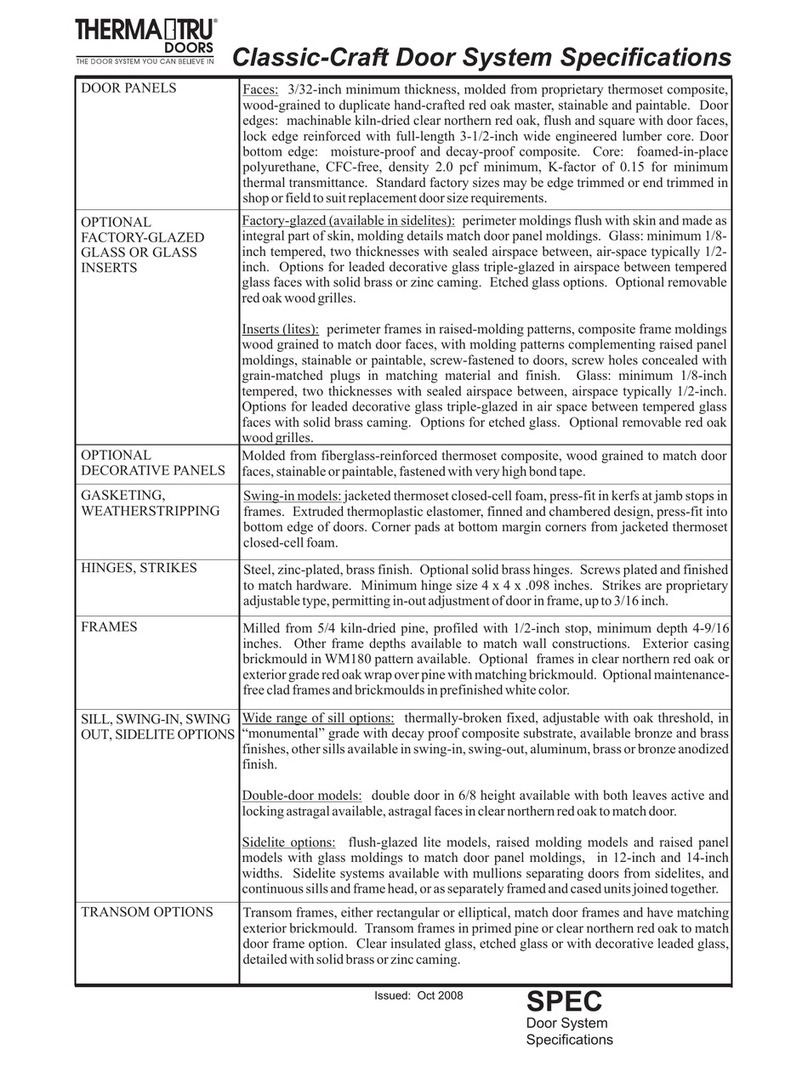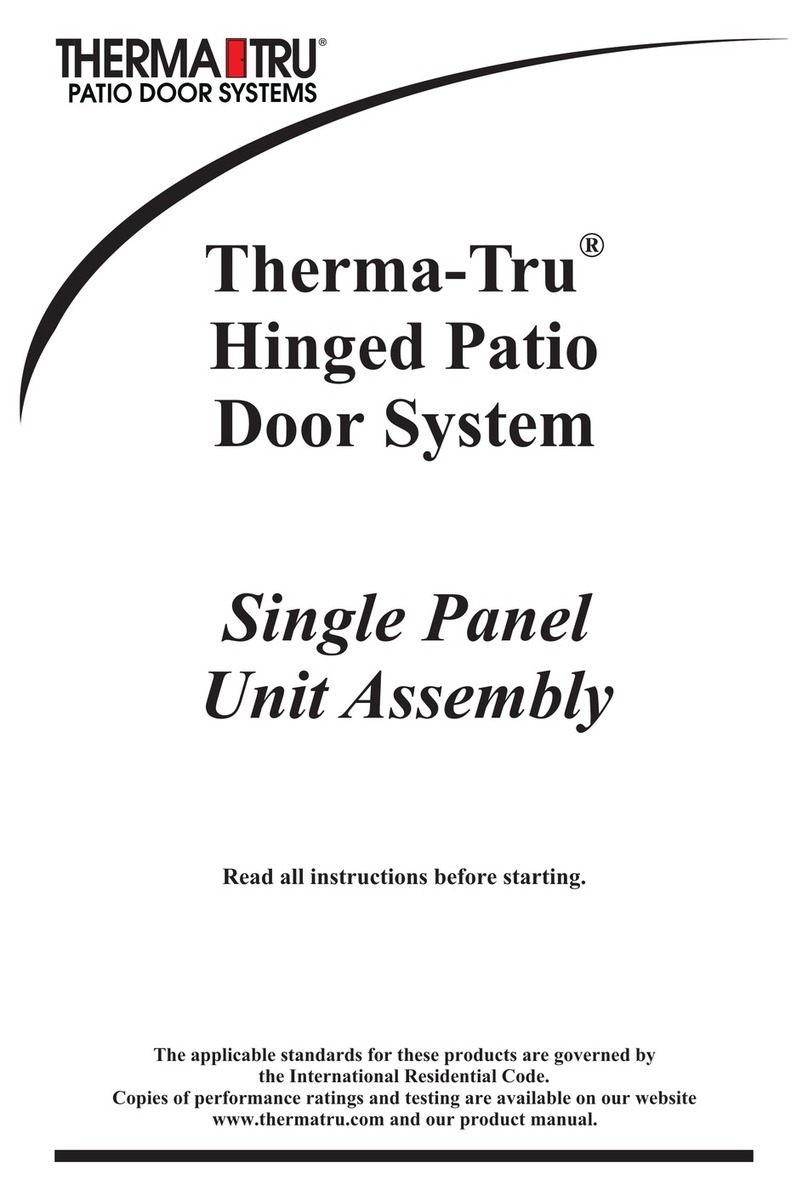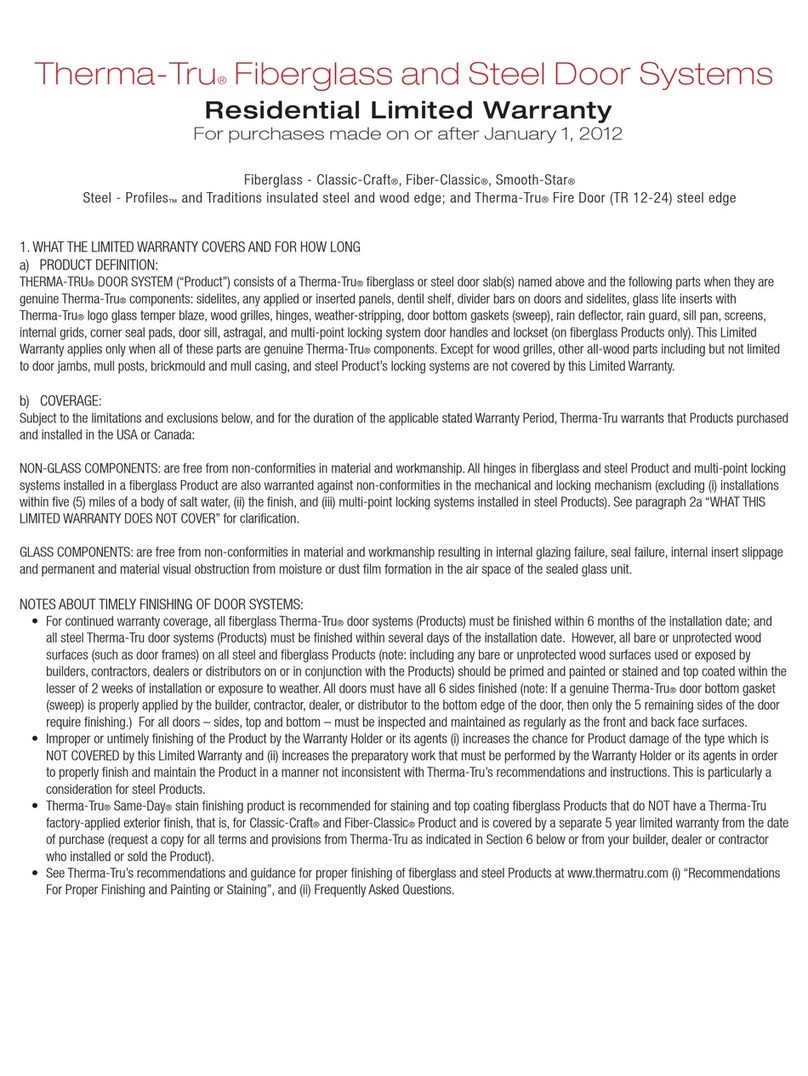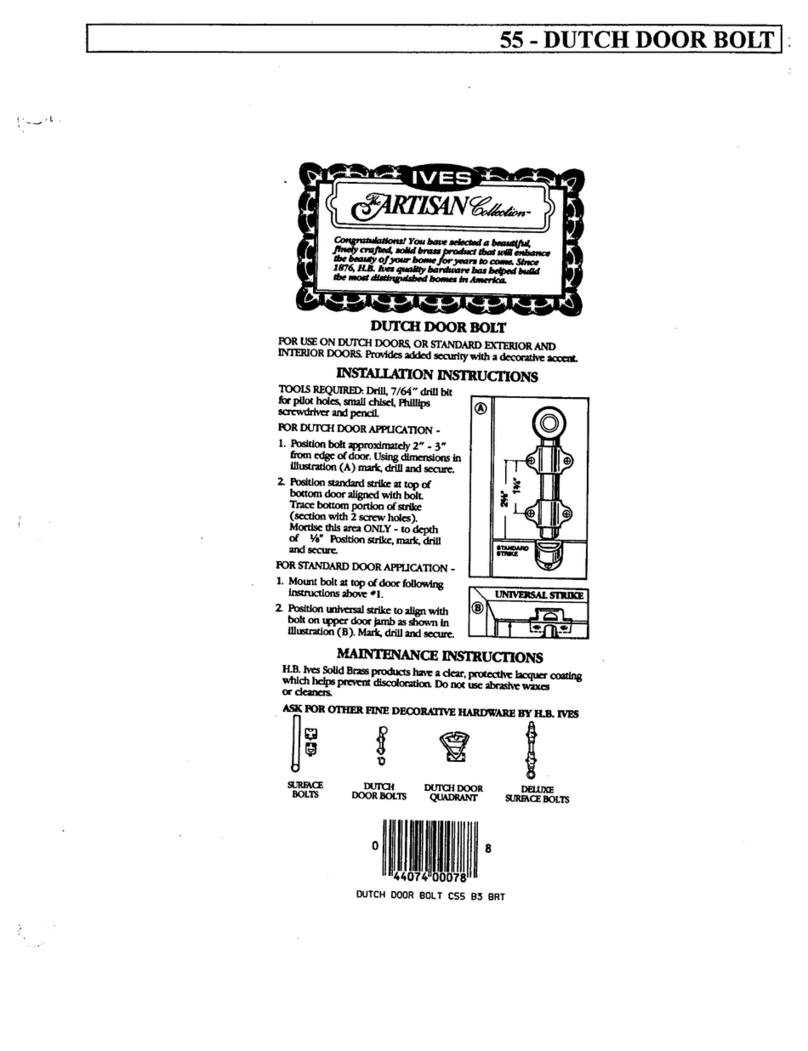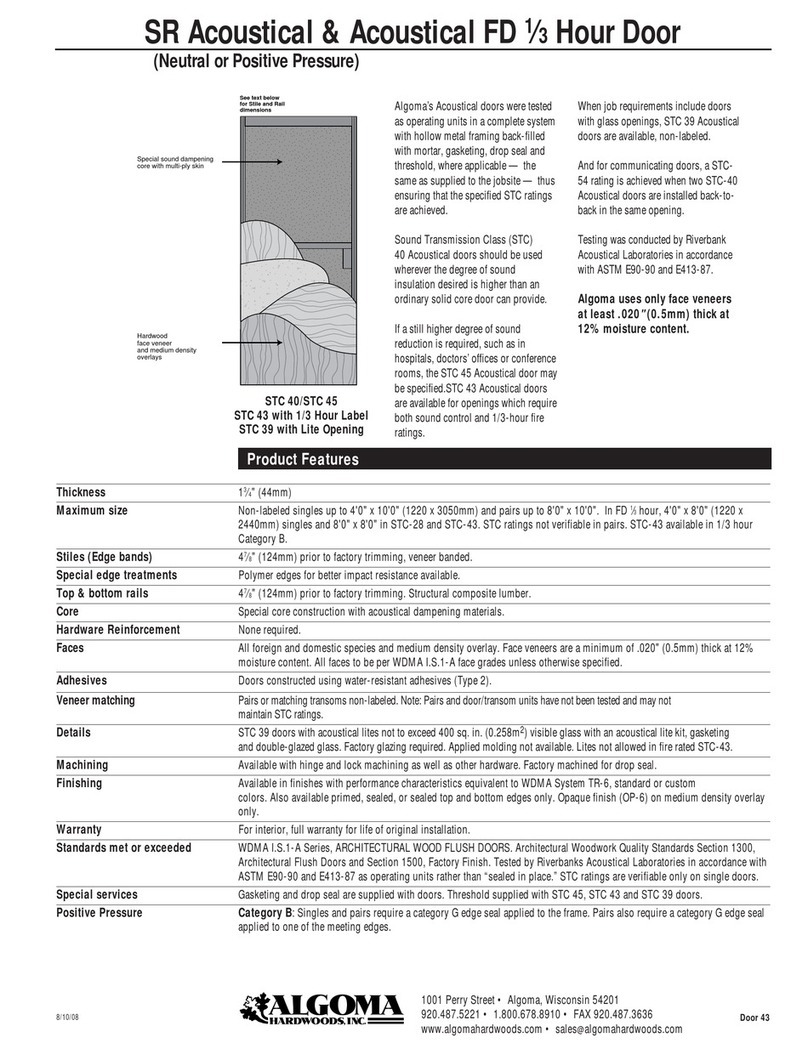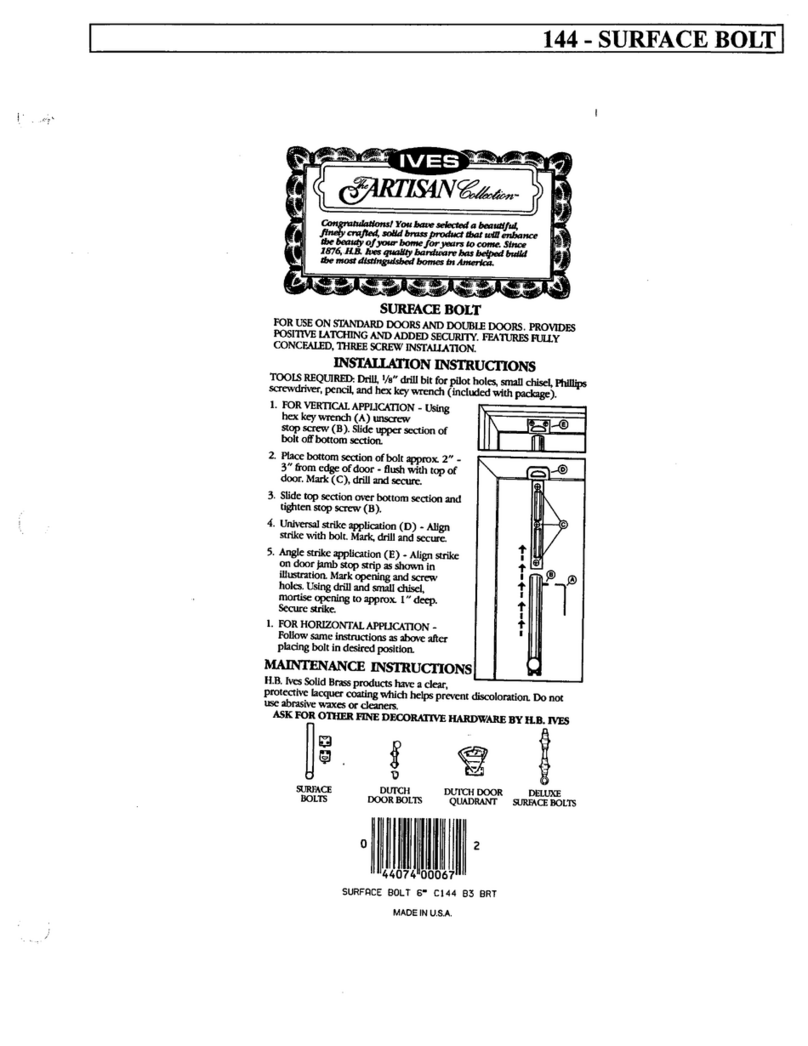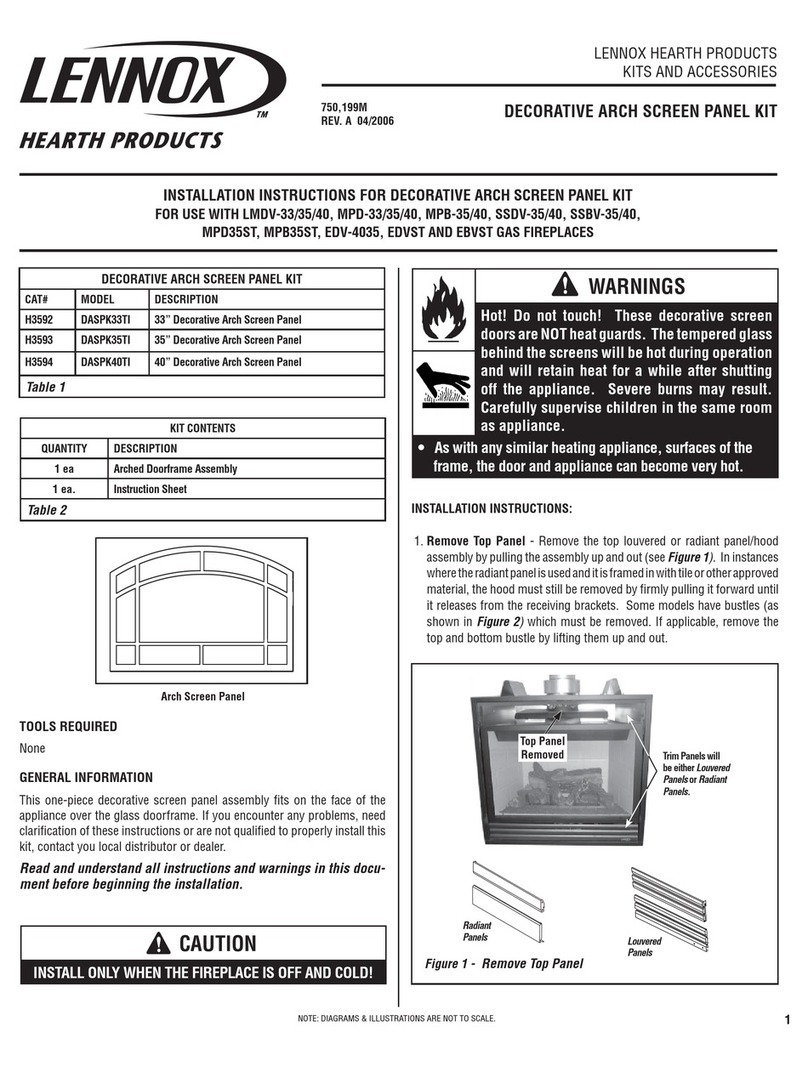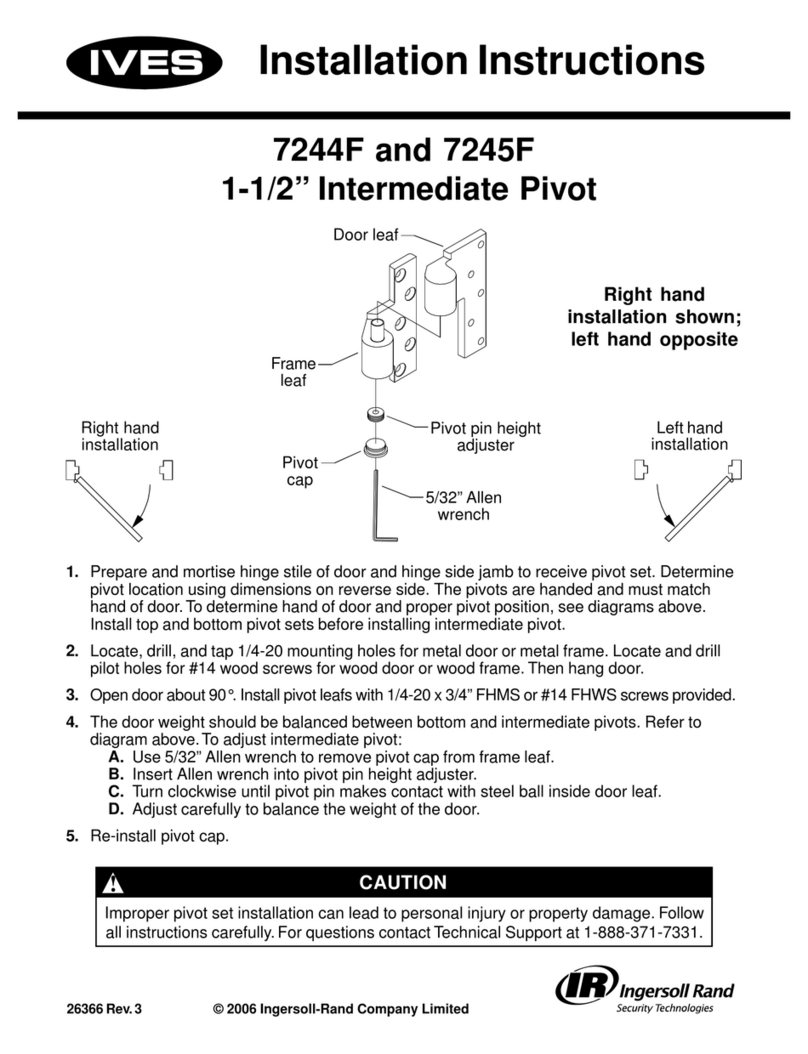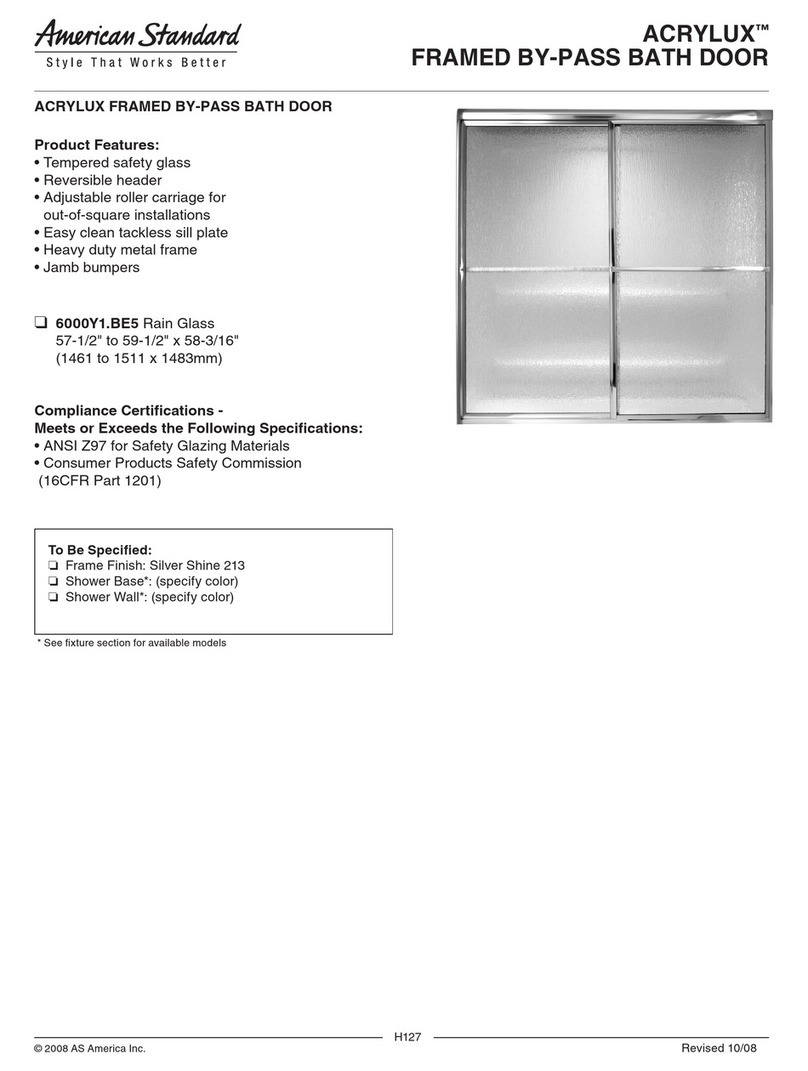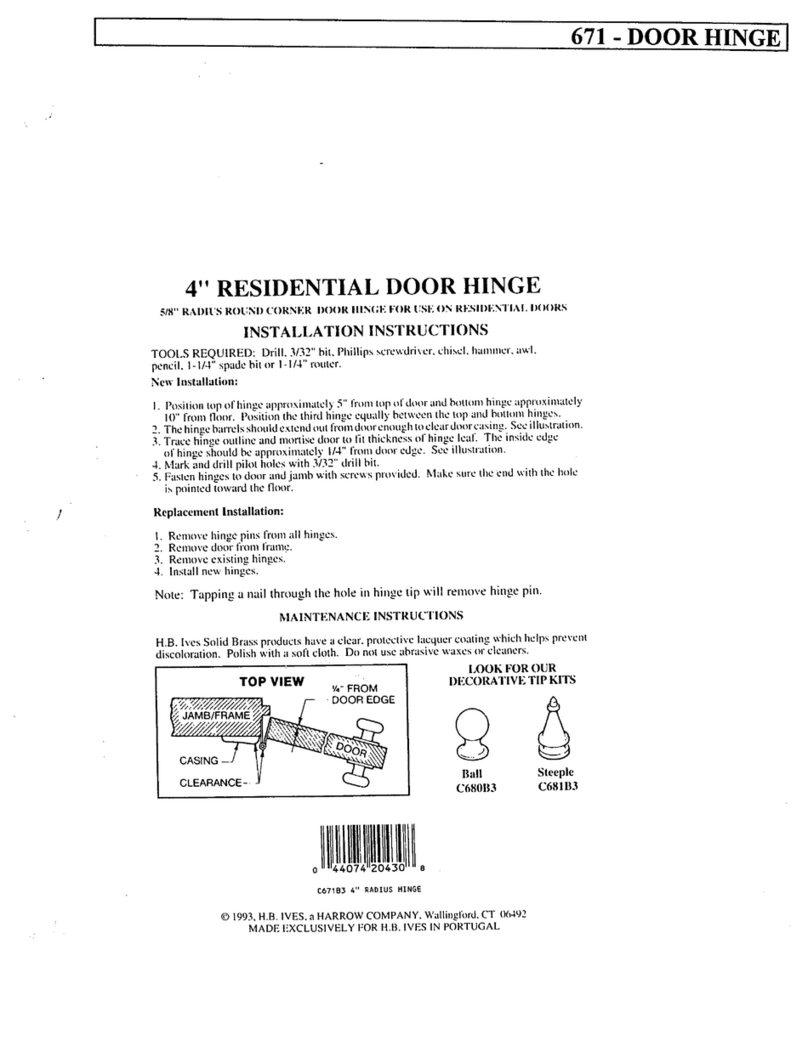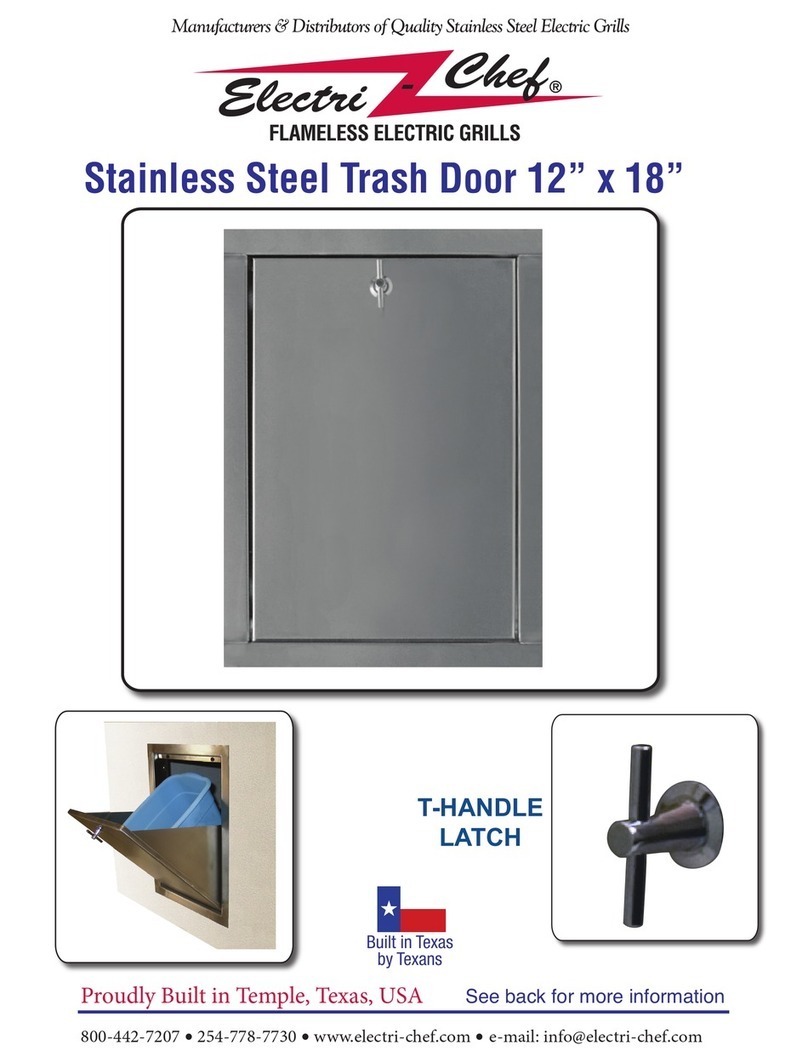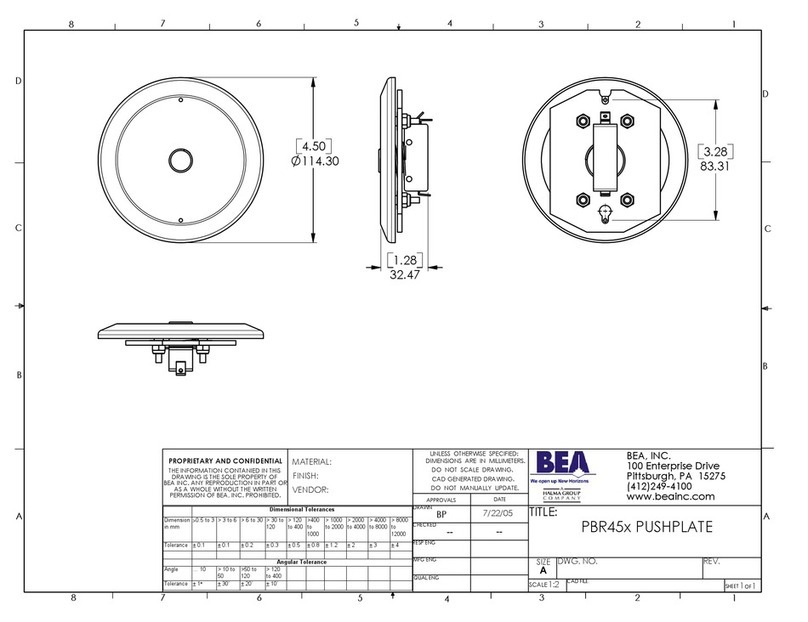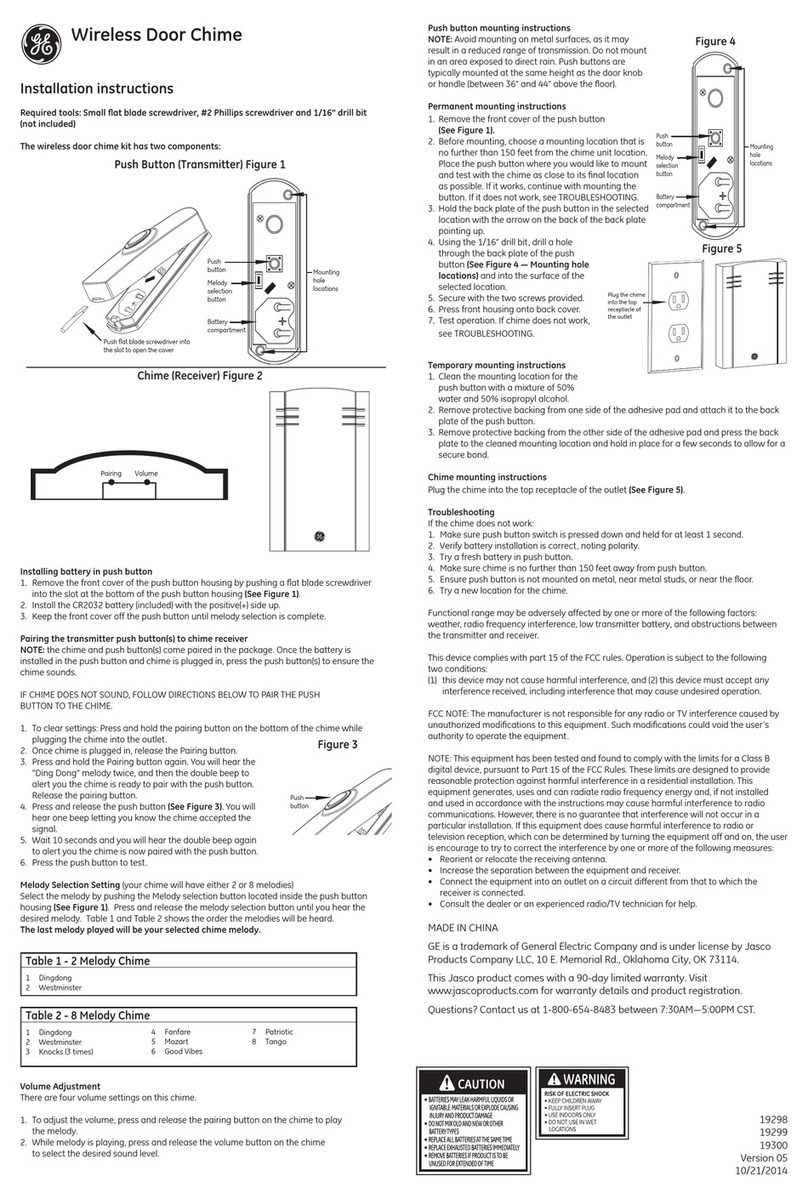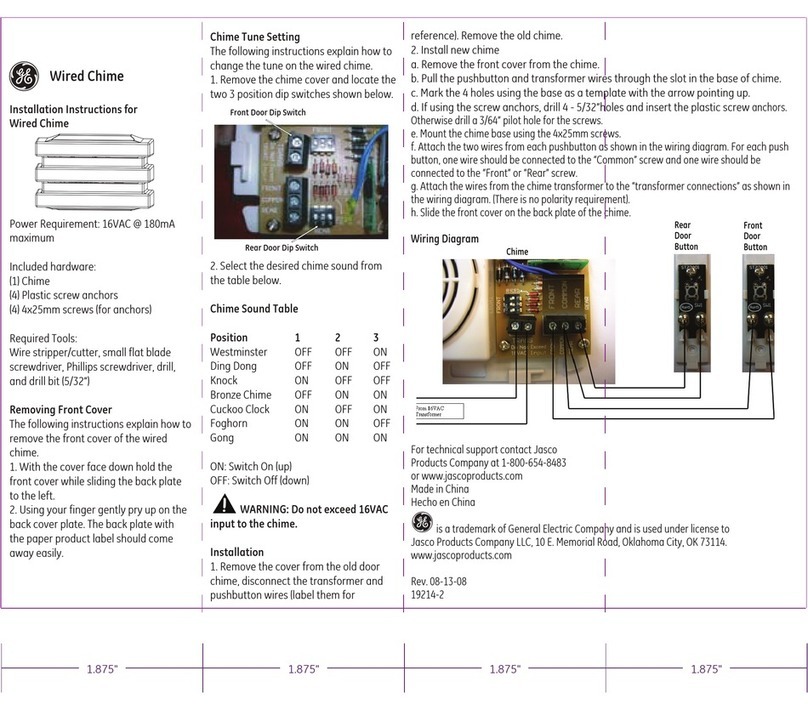
Paso 10, cont.: anclaje adicional del marco.
Puertas con vidrieras laterales:
Coloque calzas sobre los listones verticales o
las jambas de puerta que separan las puertas
de las vidrieras laterales. Atornille a través
del marco hasta el dintel, junto a las calzas.
Puertas dobles:
Coloque calzas temporales sobre el centro del
marco del dintel, donde se unen las puertas.
Pretaladre e inserte un tornillo, a través del
marco, en el dintel y luego retire las calzas
temporales.
Puertas para patio:
Coloque calzas sobre los listones verticales,
pretaladre e inserte un tornillo, a través del
marco, en el dintel, a cada lado de los
listones.
Paso 11: deje a prueba de intemperie, aplique un acabado y dé mantenimiento.
Proporcione y mantenga una cubierta o un
tapajuntas del dintel adecuadamente instalados
para proteger la parte superior de las superficies
del ingreso de agua y del daño. Coloque cinta
adhesiva y selle de manera adecuada la parte
superior de la lengüeta de la barrera resistente al
agua (WRB) sobre el tapajuntas del dintel.
Calafatee alrededor de todo el lado expuesto al clima de la unidad, sellando a lo largo de
la moldura hasta el material de tapajuntas o los revestimientos y selle todas las uniones
entre las jambas y las molduras.
Selle las uniones entre el reborde de los accesorios exteriores y el frente de la puerta para
evitar la filtración de aire y agua.
Coloque y ajuste clavos galvanizados para acabado a través de la moldura, alrededor del
perímetro. Use tornillos para exteriores si está instalando una contrapuerta en la moldura.
Avellane todos los sujetadores y cúbralos con masilla para exteriores.
Añada material de aislamiento a la cavidad entre la abertura y la unidad, a fin de reducir
la filtración de aire y la transferencia de calor.
Todas las puertas de acero Therma Tru deben finalizarse dentro de los días siguientes a la
fecha de la instalación para una adecuada cobertura de la garantía. Para puertas de fibra
de vidrio, el acabado debe darse dentro de los 6 meses después de la instalación.
Pinte o tiña de acuerdo con las instrucciones de acabado de Therma Tru. No pinte ni tiña
el burlete, está ajustado para la fricción y se retira fácilmente para pintar o teñir.
Las puertas de apertura hacia fuera deben tener acabados en todos los bordes, los
costados, la parte superior y la parte inferior. Inspeccione y dé mantenimiento a estos
bordes con la misma regularidad que con todas las demás superficies.
Se debe dar acabado a los 6 lados de las puertas. Para las puertas que se abren para
afuera, los lados, la parte superior y la parte inferior deben inspeccionarse y conservarse
con la misma regularidad que las otras superficies.
Dé mantenimiento o reemplace los selladores y acabados tan pronto el deterioro sea
evidente. En el caso de la pintura brillante o semibrillante y de las capas transparentes,
hágalo cuando la superficie se vuelva opaca o áspera. Los climas y las exposiciones más
rigurosos necesitarán de mantenimiento más frecuente.
Ingrese a nuestro sitio Web www.thermatru.com para obtener versiones imprimibles
de la instalación e instrucciones para el acabado el mismo día y para consultar nuestro
vídeo de solución de problemas sobre problemas y ajustes menores de la instalación.
Instrucciones para el acabado:
Trabaje sólo cuando las temperaturas se encuentren entre 10 y 32,2º C y la humedad sea
menor a un 85%. No aplique acabados bajo la luz solar directa.
Puertas de acero y Smooth-Star®
Para pintar puertas: primero limpie con un detergente suave y agua o use una solución
de TSP (fosfato trisódico). Enjuague bien y deje secar completamente. Proteja los
accesorios, los vidrios y los burletes antes de pintar. Use pintura látex de casas de alta
calidad y siga las instrucciones del fabricante para su aplicación. Use acabados para
exteriores para las superficies exteriores. Pinte los bordes y los extremos expuestos de la
puerta..
Para pintar marcos de vidrieras para puertas: Primero retire cualquier exceso de
sellador de esmalte para vidrios rociando con un limpiador de ventanas o agua. Use una
navaja de un solo filo para hacer cortes en el esmalte a lo largo del borde del marco.
Raspe el esmalte del vidrio sosteniendo la cuchilla de la navaja en un ángulo de 45
grados. Retire el residuo restante con un limpiador de ventanas o aguarrás mineral.
Limpie el marco con un detergente suave y agua o use una solución de TSP. Enjuague
bien y deje secar completamente. Proteja el vidrio. Aplique una pintura base de resina
alquídica o acrílica a los marcos de vidrieras. Deje secar la pintura base antes de aplicar
las capas de pintura de acabado. Use pintura látex de casas de alta calidad y siga las
instrucciones del fabricante para su aplicación. Use acabados para exteriores para las
superficies exteriores.
Puertas Classic-Craft® y Fiber-Classic®:
Para dar acabado a marcos de vidrieras para puertas y a accesorios para paneles:
primero retire cualquier exceso de sellador de esmalte rociando con un limpiador de
ventanas o agua. Use una navaja de un solo filo para hacer cortes en el esmalte a lo largo
del borde del marco. Raspe el esmalte del vidrio sosteniendo la cuchilla de la navaja en
un ángulo de 45°. Retire el residuo restante con un limpiador de ventanas o aguarrás
mineral. Proteja el vidrio. Pinte o tiña usando los mismos materiales de la puerta.
(Consulte abajo.)
Para pintar puertas:
primero limpie con un detergente suave y agua o use una solución de TSP (fosfato
trisódico). Enjuague bien y deje secar completamente. Aplique una pintura base de resina
alquídica o acrílica. Deje que la pintura base se seque completamente, luego, pinte con
pintura látex de casas siguiendo las instrucciones del fabricante para su aplicación. Use
una pintura base y una pintura que sean compatibles. Use acabados para exteriores para
las superficies exteriores. Pinte los bordes y los extremos expuestos de la puerta.
Para teñir puertas:
primero limpie con un paño limpio y aguarrás mineral y deje secar al aire o lave la puerta
con un detergente suave y agua o una solución de TSP (fosfato trisódico). Enjuague bien
y deje secar completamente. En el caso de las superficies teñidas, sólo recomendamos el
uso de tintes y productos de capas transparentes que se encuentran en el kit para
acabado Therma-Tru Same-Day Stain™. Aplique el tinte con un paño. Mientras más
tiempo se deje el tinte para “asentarse” antes de limpiarlo, más oscuro será el color. Use
un paño limpio para limpiar el tinte hasta lograr el tono del color que desea. Retire
cualquier exceso de tinte de las grietas del panel con la brocha de espuma que se incluye.
Deje secar el tinte durante al menos 6 horas antes de aplicar una capa superior. Consulte
las instrucciones del kit para acabado Therma-Tru Same-Day Stain™ para obtener
información detallada.
Advertencia:
La modificación o el mecanizado de este producto puede liberar polvo de madera,
una sustancia que el Estado de California reconoce como causante de cáncer.
